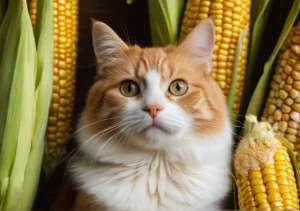
Looking for the purrfect meal for your indoor feline companion is like trying to find a needle in a catnip stack. From endless rows of flashy bags to the bombardment of “best choice” promises, feeding your furball can suddenly feel like a daunting task.
This post will guide you through the forest of options to the best dry cat food for keeping your indoor cat not just happy, but thriving.
Quick Takeaways:
- Choose dry cat food with real meat as the first ingredient to meet your indoor cat’s protein needs.
- Avoid fillers like corn and wheat to prevent unnecessary weight gain; look for added fiber for fullness.
- Seek foods enriched with omega fatty acids, taurine, and prebiotics for your cat’s coat, heart, and digestive health.
What Makes Dry Food Suitable for Indoor Cats?
Indoor cats have a world of their own, from lounging on sunny windowsills to ruling their indoor kingdoms from atop the refrigerator. Their lifestyle, however, is notably less active than their adventurous outdoor counterparts, making their nutritional needs distinct. When choosing the best dry cat food for indoor fur babies, there are a few key factors to keep in mind:
- Calorie Content: Indoor cats are like couch potato champions; they simply don’t burn as many calories. Look for foods with slightly lower calorie counts to help maintain a healthy weight.
- Ingredients for Weight Management: Foods that include lean proteins help support muscle without adding unnecessary fat. It’s like choosing grilled chicken over fried for ourselves.
- Fibers for Hairball Prevention: Indoor cats groom themselves more often, which can lead to hairballs. Dry foods with added fibers aid in moving those hairballs right through their system, reducing the likelihood of your cat coughing up a fuzzy surprise on your carpet.
A little tip? Check for dry cat foods specifically labeled for indoor cats, as they’ve been balanced with these factors in mind.
How Can You Tell if a Dry Cat Food is of High Quality?
Walking through the pet food aisle can feel like decoding a secret language. Here’s your cipher to cutting through the jargon and ensuring you’re bringing home the crème de la crème of kibble for your kitty:
- Read and Interpret Labels: The ingredients list is your treasure map to quality. Ingredients are listed by weight, so you want a meat (like chicken, beef, or salmon) to be the first on the list. It ensures protein, crucial for your feline’s health, is the primary component.
- Meat as the First Ingredient: Cats are obligate carnivores; meat is a must for their diet. A high-quality dry cat food proudly lists a specific type of meat first, not a meat by-product.
- Fillers vs. Nutritious Components: Fillers are ingredients that provide little nutritional value (think corn or wheat gluten). In contrast, nutritious components support overall health (like omega fatty acids or fiber). Choose the latter for a happier, healthier cat.
- Vet the Brand: Look up the brand’s recall history and read reviews. Brands transparent about their ingredients sourcing and manufacturing practices are generally more trustworthy.
Remember, a higher price doesn’t always indicate higher quality, but cheap food often cuts nutritional corners. Balance your budget with the best you can afford for your furball.
Are There Specific Ingredients You Should Look For?
Absolutely! When scanning the back of that cat food bag, keep your eyes peeled for some key health-boosting ingredients:
- Omega Fatty Acids: These are the secret to a shiny coat and healthy skin. Just like how avocados and salmon are good for us, omega-3 and omega-6 fatty acids are excellent for your cat.
- Taurine: An essential amino acid, taurine supports heart health and eyesight. Since cats cannot produce it naturally, it’s crucial their food contains a healthy dose.
- Prebiotics and Probiotics: To keep your cat’s digestive system running smoothly, look for foods that include prebiotics or probiotics. These support the growth of beneficial bacteria in your cat’s gut, aiding in digestion and overall health.
An often-overlooked ingredient that’s a game changer for indoor cats is chicory root. This non-digestible plant fiber is a natural prebiotic that helps reduce the occurrence of hairballs and improves digestive health. It’s the secret ingredient most cat owners don’t know they should look for, but once they do, it can make a significant difference in their cat’s well-being.
When it comes to feeding your indoor cat, knowledge is power. Armed with these insights, you’re well on your way to choosing the best dry cat food that supports a healthy, happy life for your feline friend. Remember, the best diet for your cat is one that meets their unique nutritional needs, supports their health, and fits your budget. Happy feeding!
What About Allergies and Dietary Sensitivities?
When it comes to our feline friends, it’s not just about keeping them fed—it’s about keeping them healthy and happy. Part of that means navigating the tricky waters of allergies and dietary sensitivities. It’s like playing detective, figuring out what’s causing that itch or upset stomach, then zeroing in on a diet that sidesteps trouble.
Identifying Signs of Food Allergies or Sensitivities in Cats: Look out for itching, excessive grooming, vomiting, diarrhea, or even ear infections. If your cat’s showing any of these signs, a chat with your vet is in order to rule out other causes and maybe suggest an elimination diet.
Common Problematic Ingredients: The usual culprits? Beef, dairy, and fish. Sometimes, grain or gluten gets a bad rap, too. But remember, each cat is unique; what irritates one might be totally fine for another.
Choosing the Right Food: Here’s where you can shine as a pet parent. For sensitive systems, seek out dry cat foods labeled as hypoallergenic or limited ingredient. These formulas are designed with fewer components, making it easier to pin down any allergens. Always check the ingredient list—the simpler, the better, especially for sensitive tummies.
A unique tip? Don’t overlook the benefits of novel protein sources like venison or duck. These aren’t just fancy flavors; they’re often game-changers for cats with allergies, as they’re less likely to trigger a reaction.
Can Diet Impact an Indoor Cat’s Activity Level and Overall Wellness?
Absolutely, and there’s a heap of evidence to prove it. Just like us, what a cat eats can significantly affect their mood, energy, and waistline. Since indoor cats tend to get less exercise, choosing the right dry food is crucial for keeping them sprightly and spry.
Maintaining an Ideal Weight: Obesity is a real concern for couch-loving kitties. The best dry foods for indoor cats pack a high-protein punch, with real meat, poultry, or fish taking center stage. Avoid fillers like corn and wheat that can lead to weight gain and look for recipes with added fiber to help them feel full longer.
Encouraging Play and Exploration: A diet rich in antioxidants and healthy fats (like omega-3 and omega-6) doesn’t just keep their coat shiny; it supports brain health, too, making your cat more curious, playful, and engaged. Bonus: These nutrients also bolster the immune system, a win-win for indoor cats.
Mental Health Matters: Don’t forget the mind-body connection. Boredom and stress can lead to overeating. Rotate toys, introduce puzzle feeders, and ensure your cat’s diet includes the right balance of nutrients to support not just their physical, but also their mental well-being.
Remember, the best diet for your cat depends on their individual health, age, and level of activity. Consult your vet to tailor their meals to their needs, and watch your indoor cat thrive on the right blend of care and nutrition.
Alex, a passionate animal lover, has experience in training and understanding animal behavior. As a proud pet parent to two dogs and three cats, he founded AnimalReport.net to share insights from animal experts and expand his knowledge of the animal kingdom.





Recently I subscribed to this fantastic website, they share useful knowledge with followers. The site owner is gifted at educating fans. I’m delighted and hope they maintain their wonderful skills.
Your posts always make me feel like I’m not alone in my struggles and insecurities Thank you for sharing your own experiences and making me feel understood
Your posts always provide me with a new perspective and encourage me to look at things differently Thank you for broadening my horizons